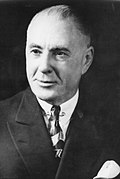| West Virginia's 1st congressional district | |
|---|---|
Interactive map of district boundaries since January 3, 2023 | |
| Representative | |
| Population (2024) | 861,893 |
| Median household income | $56,624 [1] |
| Ethnicity |
|
| Cook PVI | R+22 [2] |
West Virginia's 1st congressional district is currently located in the southern half of the state and includes Charleston and Huntington, as well as the smaller cities of Beckley, Bluefield, Lewisburg, Princeton, and White Sulphur Springs.
Contents
- History
- Composition
- Recent election results from statewide races
- List of members representing the district
- Recent election results
- 2000s
- 2010s
- 2020s
- Historical district boundaries
- See also
- References
Responding to the census results, the state legislature adopted a new map for the 2022 elections and the following 10 years. It abandoned the practice used since the formation of the state of starting the numbering in the north, and rather divided the state in a northern and southern district, with the 1st being the more southerly one. The new 1st district contains the counties of Boone, Braxton, Cabell, Calhoun, Clay, Fayette, Gilmer, Greenbrier, Jackson, Kanawha, Lincoln, Logan, Mason, McDowell, Mercer, Mingo, Monroe, Nicholas, Pendleton, Pocahontas, Putnam, Raleigh, Roane, Summers, Wayne, Webster, Wirt, and Wyoming. [3] For all intents and purposes, it was the successor to the 3rd district, and its congresswoman, Carol Miller, became the de facto incumbent in this new district. The state's other congressmen, Republicans David McKinley and Alex Mooney, were both drawn into the new 2nd district. All three ran for re-election. [4] Miller was easily nominated in the Republican primary held May 10, 2022, while former 1st district congressman David McKinley was soundly defeated by 2nd district congressman Alex Mooney. [5] Both Republicans were easily elected in November.
In its previous incarnation, the 1st covered the northern part of the state, and was historically the most regularly drawn district in the state. From 1953 to 2023, it was represented by only four men: Bob Mollohan (D) (1953–1957), former Governor Arch Moore, Jr. (R) (1957–1969), Bob Mollohan again (1969–1983), Alan Mollohan (1983–2011) and McKinley (2011-2023).
Despite the lack of turnover in the congressional seat, historically the 1st was not safe for either party. The cities are ancestrally Democratic strongholds, while the rural areas were much more conservative and had a tendency to swing Republican more often. As late as 2014, state legislators were roughly split between both parties.
For most of the 20th century, the Democratic vote in the cities was enough to keep the district in Democratic hands. However, West Virginia Democrats tend to be somewhat more socially conservative than their counterparts in the rest of the nation, and the district has been swept up in the growing Republican trend in the state at the national level. No Democrat since Bill Clinton (who did so by a plurality in a three-way race) has carried the 1st district in presidential elections. George W. Bush carried the district both times in 2000 with 54% of the vote and 2004 with 58% of the vote. John McCain carried the district in 2008 with 56.77% of the vote while Barack Obama received 41.51%.

























